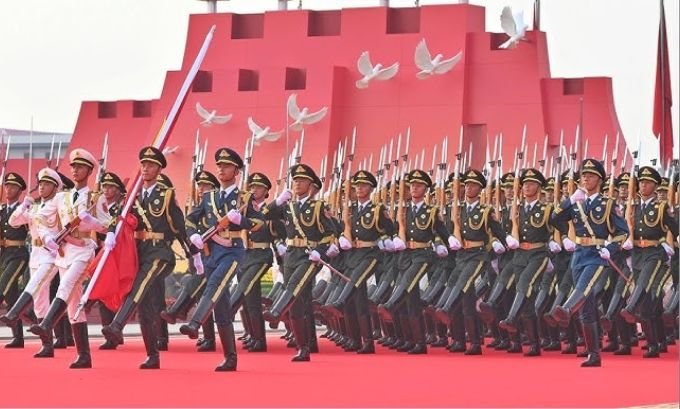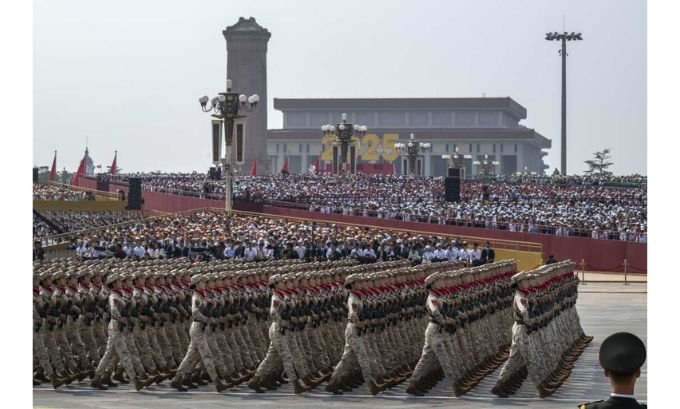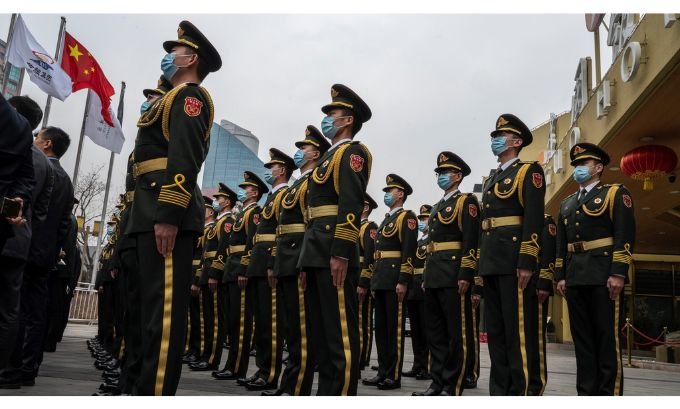The global balance of military power is shifting dramatically. China’s People’s Liberation Army has accelerated its nuclear modernization program at an unprecedented pace, fundamentally altering strategic calculations worldwide. Recent intelligence assessments reveal that China now possesses approximately 600 nuclear warheads—a figure that has grown by roughly 100 warheads annually since 2023.
This expansion represents more than numerical growth. China is simultaneously modernizing its delivery systems, expanding intercontinental ballistic missile (ICBM) infrastructure, and increasing defense spending by approximately 7.2% annually. These developments signal Beijing’s determination to establish itself as a peer competitor to the United States and Russia in nuclear capabilities. This article help you to understand abour china military power report 2025.
Understanding China’s military trajectory has become essential for policymakers, defense analysts, and anyone following international security developments. The implications extend far beyond regional dynamics, reshaping global deterrence strategies and alliance structures.
Table of Contents
The Nuclear Arsenal Expansion: From Hundreds to Thousands
China’s nuclear weapons program has entered an aggressive growth phase that breaks with decades of minimal deterrence doctrine. The current stockpile of 600 warheads represents a dramatic increase from the estimated 200-300 warheads China possessed just five years ago.
The acceleration began in earnest around 2021, but intelligence communities have documented particularly rapid expansion since 2023. Adding approximately 100 warheads per year places China on a trajectory that could see its arsenal reach 1,000 warheads by 2030. More striking still, current production capabilities suggest the possibility of 1,500 warheads by 2035 if expansion continues at this rate.
This growth pattern indicates sophisticated manufacturing capabilities and a strategic commitment to nuclear parity. Unlike previous decades when China maintained a relatively modest nuclear force, current developments suggest Beijing views nuclear weapons as essential to its great power ambitions.

Modernizing Delivery Systems: Beyond Numbers
Raw warhead counts tell only part of China’s nuclear story. The People’s Liberation Army has simultaneously invested heavily in modernizing its delivery systems, creating a more diverse and survivable nuclear force structure.
Land-Based Missile Systems
China has expanded its intercontinental ballistic missile infrastructure significantly. New missile silo fields in Gansu, Xinjiang, and Inner Mongolia provinces house next-generation ICBMs capable of reaching targets across the continental United States. These fixed installations complement mobile missile launchers, creating redundancy that enhances survivability.
The DF-41 intercontinental ballistic missile represents the current pinnacle of China’s land-based nuclear forces. With a range exceeding 9,000 miles and the capability to carry multiple independently targetable reentry vehicles (MIRVs), the DF-41 significantly multiplies China’s strike capacity.
Sea-Based Deterrent
China’s nuclear submarine fleet has grown both in quantity and capability. The Type 094 Jin-class ballistic missile submarines now carry JL-2 submarine-launched ballistic missiles, providing China with a credible second-strike capability. Development of the next-generation Type 096 submarine and JL-3 missile system promises even greater range and stealth capabilities.
Air-Delivered Options
The H-6N bomber, a modified version of China’s primary strategic bomber, can now carry air-launched ballistic missiles. This development adds a third leg to what was traditionally a two-leg nuclear force structure, moving China closer to the nuclear triad concept employed by the United States and Russia.
Defense Budget Growth: Funding Military Modernization
China’s military expansion extends beyond nuclear weapons into comprehensive force modernization. The defense budget has grown by approximately 7.2% annually, providing resources for research, development, and procurement across all military domains.
This spending level, while lower in percentage terms than some previous years, represents substantial absolute increases given China’s economic scale. The budget supports not only nuclear programs but also conventional forces, space capabilities, cyber warfare units, and military artificial intelligence development.
Investment Priorities
Recent budget allocations indicate several key priorities. Nuclear forces receive significant funding, but so do hypersonic weapons development, satellite networks, and naval expansion. This diversified approach suggests China aims to build comprehensive military capabilities rather than focusing exclusively on nuclear weapons.
The emphasis on emerging technologies—artificial intelligence, quantum computing, and advanced materials—indicates long-term thinking about future warfare capabilities. These investments may prove as significant as nuclear expansion in determining China’s military position over the coming decades.
Strategic Implications for Global Security
China’s military modernization creates ripple effects throughout the international system. Traditional arms control frameworks, designed for US-Russian nuclear competition, struggle to accommodate a third nuclear superpower with different strategic priorities.
Alliance Responses
US allies in the Indo-Pacific have begun recalibrating their security strategies. Japan is considering enhanced missile defense systems and longer-range strike capabilities. Australia has committed to acquiring nuclear-powered submarines through the AUKUS partnership. South Korea continues expanding its own missile programs while deepening security cooperation with the United States.
These responses create their own dynamics, potentially accelerating regional military competition beyond what China’s nuclear expansion alone might trigger.

Arms Control Challenges
Existing arms control treaties between the United States and Russia may become less relevant if China continues its current expansion trajectory. The New START treaty, which limits US and Russian deployed strategic warheads to 1,550 each, could lose strategic significance if China approaches similar numbers without similar constraints.
Future arms control efforts will likely require trilateral negotiations, but China has shown limited interest in formal arms control agreements that would constrain its modernization programs.
Looking Ahead: Trajectories and Uncertainties
Current trends suggest China will continue expanding its nuclear arsenal for the foreseeable future. The infrastructure investments already made indicate planning for sustained production capabilities. However, several factors could influence the ultimate trajectory.
Economic pressures might eventually constrain military spending growth, though China’s economy currently supports the defense budget increases. Technological challenges in developing more advanced delivery systems could slow certain aspects of modernization. International diplomatic pressure, while limited so far, might eventually influence Chinese decision-making.
Perhaps most significantly, China’s strategic doctrine remains somewhat opaque. Whether Beijing seeks rough nuclear parity with the United States and Russia or has more modest goals remains unclear from public statements and observable actions.
Implications for Strategic Stability
China’s military expansion fundamentally alters global strategic stability calculations. The emergence of a third nuclear superpower creates new complexities for deterrence theory and crisis management. Traditional bilateral nuclear relationships must now account for triangular dynamics that are inherently more complex and potentially less stable.
The international community faces the challenge of adapting security frameworks designed for a bipolar nuclear world to accommodate multipolar nuclear competition. This adaptation will require new thinking about alliance structures, arms control mechanisms, and crisis prevention measures.
China’s military modernization represents one of the most significant shifts in global power distribution since the end of the Cold War. Understanding these developments and their implications remains essential for anyone seeking to comprehend contemporary international security challenges.

